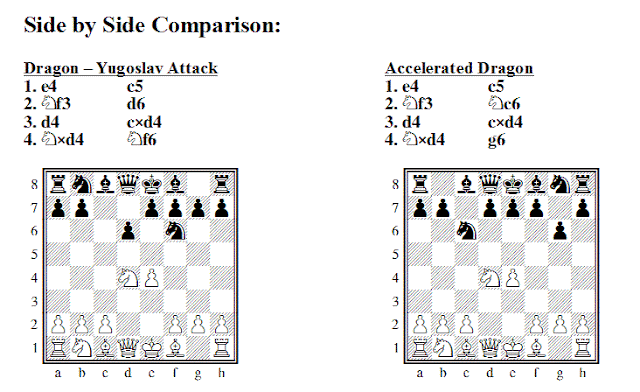Ideas in the Accelerated Dragon
Idea #8 - Maroczy Bind
White has a major option for preventing Black's plans in the Accelerated Dragon. By playing 5.c4, White can stop Black from playing ...d5. This is called the Maroczy Bind.
1.e4 c52.Nf3 Nc63.d4 cxd44.Nxd4 g65.c4
- Prevented Black from playing ...d5 any time soon
- Staked out a space advantage
- Changed the nature of the game to emphasize positional maneuvering
- Limited the scope of his light squared bishop
- Note: Black's bishop on g7 will still be a monster
White's plans will revolve around:
- Maintaining the space advantage (which means avoid trading too many pieces)
- Planting a knight on d5 (the Marco Hop), or b5
- Expanding on the queenside with b4 and c5
- or Expanding on the kinside with f4 and e5
- Exchanging dark square bishops
Black's plans are based on:
- Trading off at least one pair of knights (the knight on d4 is the first target)
- Making this trade so that White recaptures with the queen, not the bishop
- Weakening the long diagonal for the g7 bishop by playing ...Be6 prompting White to play b3
- Or weakening the long diagonal with ...a5 and ...a4
- After a Marco Hop, trading off White's knight on d4 with the bishop, leading to a good night vs bad bishop endgame. (Be prepared to defend the backward pawn on e7 after exd5.)
- Pawn breaks: ...b4 or ...f4
- Good squares for pieces:
- Knight: c5 or e5
- Bishop: c6 or e6
- Rooks: b8 and c8
- Queen: a5
This involves a specific move order:
- 5...Nf6 (prompting 6.Nc3) and 6...e6 come first. This creates the threat of 7...Ng4
- White would like to put a bishop on e3, but usually plays 7. Be2 because of blacks threat
- Now is the time to trade: 7...Nxd4, since White will have to re-capture with queen.
- finally 8...Bg7 and 9...O-O.
Here is a game showing many of these ideas:








